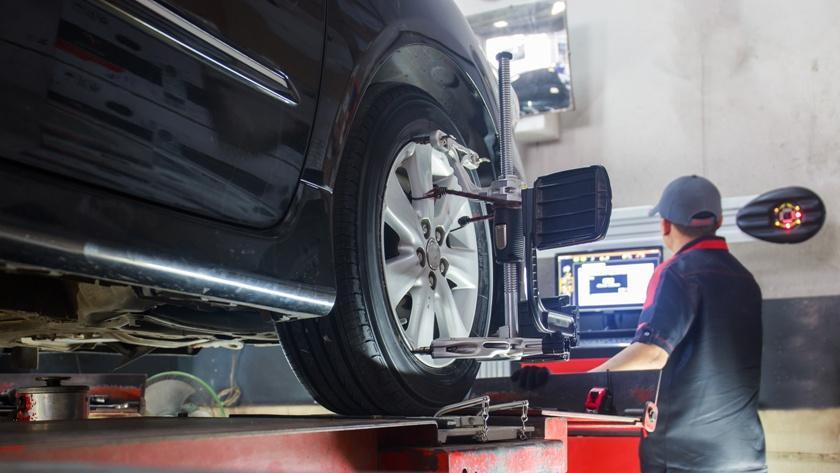To help your vehicle drive in the safest and best condition possible, it is important to make sure that you maintain the correct car alignment and wheel balancing. Because it is difficult to know the difference between wheel alignment and wheel balancing, it is important to have them checked on a regular basis at your auto shop. Whether it’s a misalignment or a lost tire balance, it will eventually damage your tires, your suspension system, and/or your steering system. When these problems are ignored, your vehicle becomes a safety hazard on the road.
You may be wondering how a tire gets “out of balance.” Imperfections, blemishes in the rubber, and damage to a tire or rim can throw a wheel "out of balance." That means that one section of the tire or rim is heavier. So how is a tire balanced? One wheel at a time is removed from the car and placed on a computerized machine and spun around to determine which side is the heaviest. A small lead weight is then attached to the tire to counter-balance any heavy spots. Once the weight is the same on all sides of the wheel, the wheel will spin on the machine with ease. You should have your wheels balanced any time your tires are repaired or rotated.
So what is the difference between wheel alignment and wheel balancing? When your car rolled off the assembly line, it came preset with special angles that position your tires correctly. The correct car alignment ensures optimal drivability by keeping your wheels pointed in the right direction. Improper wheel or tire alignment can cause your tires to wear unevenly and prematurely. If you’re experiencing unusual wear patterns, you should have a technician check your car alignment. While tire wear prevention is a good reason to keep your wheel alignment in check, the consequences of misalignment can also play out in overall vehicle performance.
Many drivers are not sure if their vehicle has lost its alignment or a wheel has lost its balance as many of the signs are similar. Some of the signs to watch for include:
- A vehicle pulling to the left or right
- Uneven or rapid tire wear.
- A steering wheel is crooked, it feels “loose,” or it vibrates
- Squealing or wobbly tires
Having tires aligned and balanced every 5,000 to 6,000 miles can help maximize their lifespan and overall performance. Your auto mechanic can determine what is needed and take care of it quickly and easily.
Need to know more about wheel alignment and wheel balancing? Contact our ASE Certified Technicians at Clausen Automotive, The Hybrid Shop, for more information about vehicle alignment and to schedule an appointment. Since 1975, our family-owned auto shop has proudly served vehicle owners in Madison, WI, and the surrounding communities.
Consider the negative effects to your car if you don’t keep your tires balanced properly. It is vital to know the difference between wheel alignment & balancing.
To help your vehicle drive in the safest and best condition possible, it is important to make sure that you maintain the correct car alignment and wheel balancing. Because it is difficult to know the difference between wheel alignment and wheel balancing, it is important to have them checked on a regular basis at your auto shop. Whether it’s a misalignment or a lost tire balance, it will eventually damage your tires, your suspension system, and/or your steering system. When these problems are ignored, your vehicle becomes a safety hazard on the road.
You may be wondering how a tire gets “out of balance.” Imperfections, blemishes in the rubber, and damage to a tire or rim can throw a wheel "out of balance." That means that one section of the tire or rim is heavier. So how is a tire balanced? One wheel at a time is removed from the car and placed on a computerized machine and spun around to determine which side is the heaviest. A small lead weight is then attached to the tire to counter-balance any heavy spots. Once the weight is the same on all sides of the wheel, the wheel will spin on the machine with ease. You should have your wheels balanced any time your tires are repaired or rotated.
So what is the difference between wheel alignment and wheel balancing? When your car rolled off the assembly line, it came preset with special angles that position your tires correctly. The correct car alignment ensures optimal drivability by keeping your wheels pointed in the right direction. Improper wheel or tire alignment can cause your tires to wear unevenly and prematurely. If you’re experiencing unusual wear patterns, you should have a technician check your car alignment. While tire wear prevention is a good reason to keep your wheel alignment in check, the consequences of misalignment can also play out in overall vehicle performance.
Many drivers are not sure if their vehicle has lost its alignment or a wheel has lost its balance as many of the signs are similar. Some of the signs to watch for include:
- A vehicle pulling to the left or right
- Uneven or rapid tire wear.
- A steering wheel is crooked, it feels “loose,” or it vibrates
- Squealing or wobbly tires
Having tires aligned and balanced every 5,000 to 6,000 miles can help maximize their lifespan and overall performance. Your auto mechanic can determine what is needed and take care of it quickly and easily.
Need to know more about wheel alignment and wheel balancing? Contact our ASE Certified Technicians at Clausen Automotive, The Hybrid Shop, for more information about vehicle alignment and to schedule an appointment. Since 1975, our family-owned auto shop has proudly served vehicle owners in Madison, WI, and the surrounding communities.
